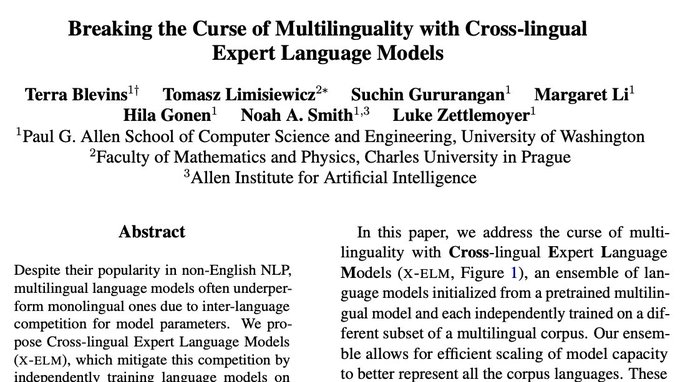
Terra Blevins
@TerraBlvns
Followers
754
Following
468
Media
21
Statuses
82
Postdoc @ViennaNLP and incoming asst professor @Northeastern @KhouryCollege || Formerly @uwcse || she/her
Seattle, WA
Joined July 2016
Don't wanna be here?
Send us removal request.
Explore trending content on Musk Viewer
#خلصوا_صفقات_الهلال1
• 838697 Tweets
ラピュタ
• 408751 Tweets
Atatürk
• 391804 Tweets
Megan
• 225825 Tweets
Johnny
• 225103 Tweets
Sancho
• 150235 Tweets
MEGTAN IS COMING
• 133896 Tweets
#4MINUTES_EP6
• 128070 Tweets
RM IS COMING
• 127281 Tweets
namjoon
• 120999 Tweets
olivia
• 118822 Tweets
Coco
• 53451 Tweets
Labor Day
• 50588 Tweets
كاس العالم
• 47821 Tweets
ミクさん
• 46553 Tweets
ムスカ大佐
• 41106 Tweets
#フロイニ
• 37547 Tweets
Arteta
• 35129 Tweets
ŹOOĻ記念日
• 24633 Tweets
ミクちゃん
• 22995 Tweets
Javier Acosta
• 22436 Tweets
Día Internacional
• 21751 Tweets
Romney
• 18098 Tweets
Ramírez
• 16983 Tweets
Lolla
• 14892 Tweets
ナウシカ
• 13796 Tweets
Lo Celso
• 12045 Tweets
Sekou Kone
• 11059 Tweets
AFFAIR EP1
• 10504 Tweets
نادي سعودي
• 10392 Tweets
Last Seen Profiles
Pinned Tweet
Universal NER is gearing up for our next data release!! We're still looking for many common-spoken languages (Spanish, Hindi, and more!), so check out the blogpost and discord if you want to help build UNER v2 ⬇️
0
2
14
I’m very excited to join
@Northeastern
@KhouryCollege
as an assistant professor starting Fall '25!! Looking forward to working with the amazing people there!
Until then I'll be a postdoc at
@ViennaNLP
with Ben Roth, so reach out if you want to meet up while I'm over in Europe ✨
28
15
281
Are any large-scale pretrained models truly monolingual? In new work with
@LukeZettlemoyer
, we find that automatic data collection methods leak millions of non-English tokens into popular pretraining corpora. (1/3)
✨Paper✨:
4
40
212
When do multilingual LLMs learn to transfer between languages? In our new preprint, we probe XLM-R across training checkpoints and find that in-language and cross-lingual training dynamics are very different!
💫Paper: (w/
@hila_gonen
and
@LukeZettlemoyer
)
2
20
147
Very excited this work is accepted to
#EMNLP2022
! Please take a look if you're interested in how monolingual models learn cross-lingual transfer
Are any large-scale pretrained models truly monolingual? In new work with
@LukeZettlemoyer
, we find that automatic data collection methods leak millions of non-English tokens into popular pretraining corpora. (1/3)
✨Paper✨:
4
40
212
0
10
112
What do autoregressive LMs know about linguistic structure? We introduce structured prompting, an approach for probing LMs by extending prompting to sequence tagging tasks without training.
🌟Paper: (w/
@hila_gonen
and
@LukeZettlemoyer
)
2
19
93
WSD models for English perform as well as humans on common senses, but worse on rare or novel senses.
FEWS, our new dataset at
#EACL2021
, focuses on evaluating WSD models on these challenging senses in a low-shot setting. (1/3)
1
15
55
This work will be at
#EMNLP2022
! Now with new experiments exploring how linguistic knowledge changes across layers over time -- we find that information is acquired at the final layer and then pushed down to lower ones during pretraining
When do multilingual LLMs learn to transfer between languages? In our new preprint, we probe XLM-R across training checkpoints and find that in-language and cross-lingual training dynamics are very different!
💫Paper: (w/
@hila_gonen
and
@LukeZettlemoyer
)
2
20
147
1
7
51
🎆 Super excited that this paper was accepted at
#ACL2023NLP
! Check it out if you're interested in how in-context learning works ➡️ We find prompting is heavily affected by task knowledge in the pretraining data, but can still generalize to unseen but descriptive labels.
What do autoregressive LMs know about linguistic structure? We introduce structured prompting, an approach for probing LMs by extending prompting to sequence tagging tasks without training.
🌟Paper: (w/
@hila_gonen
and
@LukeZettlemoyer
)
2
19
93
1
7
37
I'm presenting our new ✨Univeral NER dataset✨ at 2 PM tomorrow at
#NAACL2024
(in Don Diego, Poster Session 2). Stop by if you're interested in multilingual benchmarks and/or cross-lingual NER!
Quality multilingual annotated data is always scarce, so I'm extra happy to see ✨Universal NER✨ has been accepted at
#NAACL2024
.
We hope the project will help address the data gap and facilitate new multilingual/cross-lingual research!
🎉 Preprint:
1
12
74
0
8
34
💫 New paper! 💫
TLDR: We explore the embedding space of XLM-R and show that we can effectively reinitialize the vocabulary with simple heuristics mimicking the structure!
This lets us more efficiently adapt the model to new languages and downstream tasks🔋
What's the best way to specialize multilingual LMs for new languages? We address this in our new paper!
Embedding structure matters: Comparing methods to adapt multilingual vocabularies to new languages ()
With
@terrablvns
, Nora Goldfine, and
@ssshanest
1
1
19
1
4
27
I'm excited to present our work on "Translate to Disambiguate" at
#EACL2024
🇲🇹. Come by the Multilingual Issues oral session tomorrow (03/19) at 10:30 in Marie Louise to learn more!!
0
1
26
Excited to share this
#EMNLP2023
Findings paper here in Singapore! I'll present this tomorrow (Dec. 7) at 11:30 in the East Foyer, and again on Dec. 9 at 9am in the East Foyer. Come chat about how we can 🪄demystify our prompts
Why not all Prompts are Created Equal?
Check out our preprint "Demystifying Prompts in Language Models via Perplexity Estimation"
Joint work with
@sriniiyer88
@TerraBlvns
@nlpnoah
@LukeZettlemoyer
🧵
paper:
5
28
148
0
3
26
Super excited about this article on some of the more surprising findings of our
#ACL2023
paper on structured prompting! Stop by our poster (Tues, 9am-10:30 EST) to chat if you want to learn more ✨
0
6
20
This project has been so much fun to work on! Check out this thread to learn about our new multilingual NER dataset, 🪐Universal NER🌟
0
7
21
Check out the paper () for many more experiments and analyses, including our ICL results on downstream tasks (it works!) 💫
This work was done with my wonderful collaborators
@TomLimi
@ssgrn
@margs_li
@hila_gonen
@nlpnoah
@LukeZettlemoyer
n/n
0
0
6
@Amrkeleg
@tellarin
@mayhewsw
@hila_gonen
@josephimperial_
@ljvmiranda
@nljubesic
@lpq29743
@yuvalpi
@mr__shu
@barbara_plank
@Shuheng_Liu
@ChunyuanDeng
@EmilStenstrom
@ArijRiabi
@peterkz_swe
The Arabizi results are included in the camera ready () — we’ll make sure to update the arxiv version to match
1
0
7
We find current SoTA methods lag behind humans on FEWS, indicating that it will support significant future work on low-shot WSD. Work done with
@mandarjoshi_
and
@lukezettlemoyer
. (3/3)
1
1
6
See the 📃 for other cool insights on getting PLMs to make sense at scale! With my amazing collaborators
@haoqik322
and
@LukeZettlemoyer
💫
Paper ➡ (n/n)
0
1
5
@yong_zhengxin
No, you aren't missing anything! This is a summary of some of the results in Table 1
0
0
1
@evgeniyzhe
Good question -- it's due to a tokenization artifact in some of the models. I've added Appendix B to the paper to discuss this (on Arxiv soon, but you can read it here: )
1
0
2
@Wjrgo
@srchvrs
@mayhewsw
@yanaiela
@ryandcotterell
@LukeZettlemoyer
I don't think the model could handle a script not seen during pretraining -- it wouldn't have subword embeddings to handle those cases (or, if you included them, they'd be random/untrained). Appendix B of our paper discusses tokenization effects and how it affects performance.
1
0
2

























































